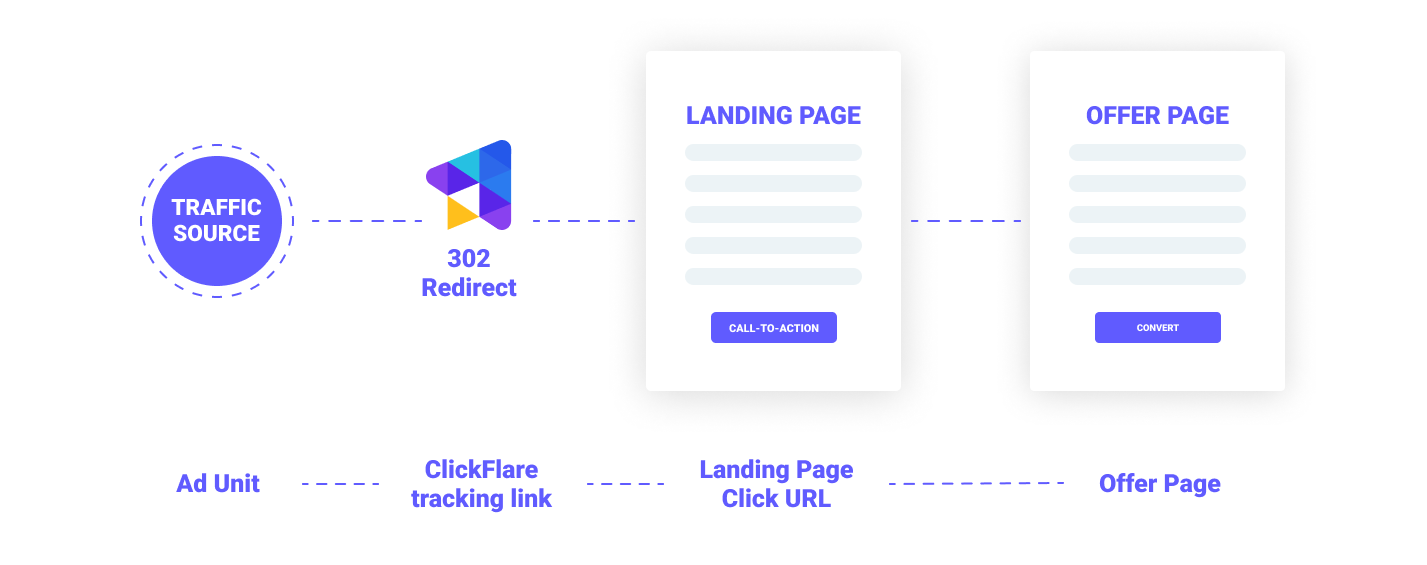Unlike traditional landing page configurations, where marketers link the URL of the offer page directly with the landing page's call-to-action, at ClickFlare we take a different approach.
Instead of linking the offer page in the landing page's call-to-action, when using ClickFlare it is best to use your tracking Click URLs instead.
Let's go over two different use cases to better understand why and how using ClickFlare's Click URLs is better and will seamlessly direct our visitors to the offer page.
Use Case 1 - Using 302 Redirect Tracking Method

As you may see in the diagram above, when using a 302 Redirect tracking method, the traffic flows from the ad unit (through a click, pop-up or redirect) to ClickFlare's campaign tracking link.
When landing on ClickFlare's campaign link, the visitor is automatically redirected to the landing page of the campaign.
In this traffic flow (which occurs in a matter of milliseconds), ClickFlare automatically recognizes the campaign this visit belongs to (using the campaign tracking link which contains the campaign id), and automatically assigns a unique id to this visit, also known as the click id.
Knowing the campaign id of which the visitor was interested in going through, ClickFlare immediately knows that any landing page clicks coming from campaign id XYZ123 have to go through offer ABC123 or offer BCD234 (in case you are split-testing offers).
In other words, although the click URL present on the landing page has nothing to do with the offer URL, the user still gets to visit the offer they are assigned to visit because that offer's destination URL is present in ClickFlare's campaign settings and ClickFlare manages that automatically.
Again the visitor transition from one node to another is a process that happens instantaneously, so they don't feel or notice any delays at all.
Use Case 2 - Using Direct/Redirectless Tracking Method
![]()
Unlike the 302 redirect method, when working with Direct, also known as the Redirectless tracking method, the visitor flow is shortened to 3 steps. So instead of going from the ad unit to ClickFlare's redirect link, the visitor goes directly to the landing page, without going through a temporary redirect.
However, when this tracking method is deployed, a slightly more advanced implementation is required.
Besides using ClickFlare's click URL present in the landing page's call-to-action, which serves to send the visitor to the offer page, an additional script needs to be placed in the landing page. This script is known as the landing page tracking script.
The landing page tracking script, practically does what the 302 campaign tracking link does, but without a redirect. The script present in the landing page automatically reads the campaign id which needs to be present in the URL query string (a.k.a. URL parameters), then automatically generates a unique visitor id, known as click id, and replaces ClickFlare's standard click URLs with the destination URL of the offer.
This way you can be compliant with any traffic source that does not prefer 302 redirects and requires you to link your ads directly with your landing page.
Comparing The Two Tracking Methods
Although both tracking methods work similarly, at least in the eyes of the visitor, where they don't feel any difference between the two methods, each of them has its ups and downs when it comes to specific situations.
Below you can find a quick side-by-side comparison of these two methods.
|
|
|
|
| Can track organic traffic | No | Yes |
| Can split-test landing pages | Yes | No |
| Is compliant with all ad networks | No | Yes |